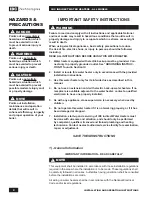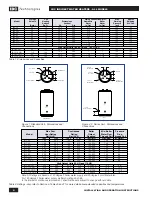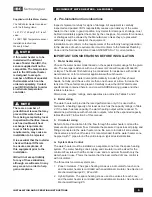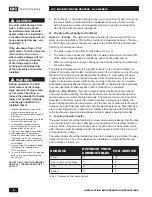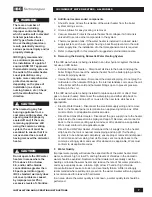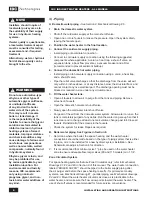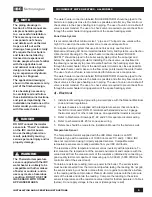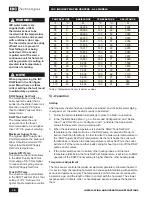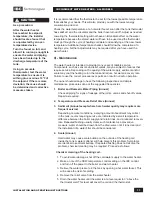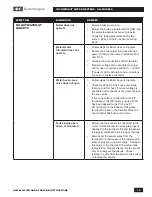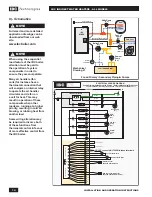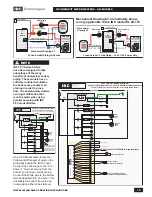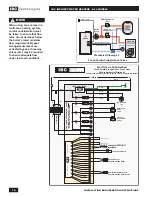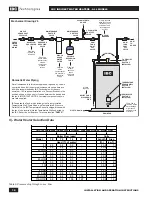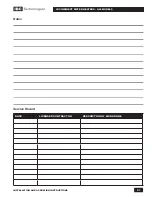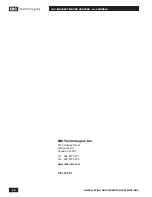
7
INSTALLATION AND OPERATION INSTRUCTIONS
IBC INDIRECT WATER HEATERS - ALL MODELS
D. Additional recommended components
1. Shut-off valves. Allows the isolation of the water heater from the boiler
system during service.
2. Unions. Allows for easy locating or removal.
3. Vacuum breaker. Protects the water heater from collapse if a hot tank is
valved off to service other components in the system.
4. Thermal expansion tank. If the water heater is installed in a closed water
supply system, such as a system having a back flow preventer in the cold
water supply line, the installation of a thermal expansion tank is required.
5. Refer to drawing #6 in this manual for suggested external components.
E. Removing the Existing Domestic Water Heating System
If the IBC water heater is being installed in an older hydronic system that does
not use an IBC boiler:
• External Tankless Heater - Disconnect all lines to the boiler and plug the
boiler fittings. Disconnect the external heater from the boiler piping, and the
domestic piping systems.
• Internal Tankless Heaters - Disconnect the domestic piping. Do not plug the
cold water or the hot water fittings in the internal tankless coil. Leave the coil
in the boiler with the cold and hot water fittings open to prevent pressure
build-up in the coil.
If the IBC water heater is being installed to replace an electric or direct fired
gas or oil water heater: Disconnect the water piping and either strip back to
the nearest main line and cap off, or re-use for the new tank, whichever is
appropriate.
• Electric Water Heater - Disconnect the electrical supply wiring and remove
back to the breaker panel or terminate in an approved junction box. Work
must conform to all applicable electrical codes.
• Direct Fired Gas Water Heater - Disconnect the gas supply line to the heater,
strip back to the nearest mains piping and cap off. Remove vent connector
back to the common venting system and seal off or abandon as applicable.
Work must conform to all applicable codes.
• Direct Fired Oil Water Heater - Disconnect the oil supply line to the heater,
strip back to the tank or nearest mains piping and cap off. If oil heating
system is to be abandoned completely, ensure proper removal and disposal
of old oil tank and remaining fuel oil. Remove vent connector back to the
common venting system and seal off or abandon as applicable. Work must
conform to all applicable codes.
F. Water Quality
Improper water quality will reduce the expected life of the water heater. Hard
water, sediment, high or low Ph, and high levels of chlorides in the domestic
water should be avoided. Sediment and hard water will eventually coat the
heating coil inside the water heater and reduce the rate of hot water production
and may, eventually cause a failure. High or low Ph and/or high chloride
concentrations will cause corrosion and eventually failure. A filter is strongly
recommended where sediment is present in the water. A water softening system
is recommended for areas with hard water.
In an area where the water quality is not known, a water quality test should be
performed.
CAUTION
Do not operate the IBC water
heaters in areas where the
Ph is above 8.0 or below
6.0, and/or with chloride
concentrations greater than
80 parts per million (ppm).
IBC’s standard warranty does
not cover problems caused
by improper water Ph or
excessive levels of chlorides.
WARNING
There are a number of
conditions, including
improper control settings,
which could result in elevated
tank temperatures from
ANY type of water heater.
An overheating hazard can
result, potentially causing
serious personal injury and/or
property damage.
IBC Highly recommends
as a minimum precaution,
the installation of a point of
source ASSE 1017 approved
thermostatic mixing valve on
the outlet of the water heater.
Local jurisdictions may
require more comprehensive
protective measures
depending on the place of
installation (ie. schools,
nursing homes, etc.). Check
with local Authorities for
direction.
CAUTION
When removing any fuel
burning appliance from a
common venting system, the
opening must be properly
sealed off and; if there are
remaining appliances still
using the common venting
system, the vent must be
examined to ensure that it is
not over-sized as a result of
having removed the old water
heater.


